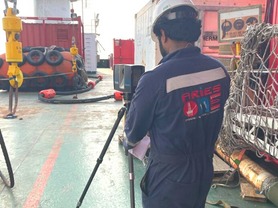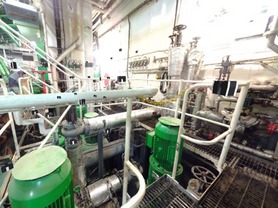

Aries uses an advanced laser 3D Scanner for generating the as-built data. In principle, the laser scanner works by sending an infrared laser beam into a rotating mirror that deflects the laser beam around the environment being scanned. These reflected images are then transferred as point clouds and then developed into a 3D model. Aries 3D scanner provides our naval architects and structural engineers with an efficient tool for rapid, seamless and precise documentation of the current status of any construction; offshore or onshore, ships, rigs, platforms, terminals, piping systems and structures of every kind. Laser Scanning is ideal for designing, ship building, restructuring and extending technical and industrial plants such as refineries, power plants and production facilities.
Complex surfaces can be captured as a dense 3D scan data by the FARO Laser Scanner. This allows to perform non-contact, 3D inspections with ease. Non-contact 3D scanning from FARO can digitize features such as flush and gap that are difficult to inspect with contact methods. Laser scanning for 3D documentation can be a faster method produces a more comprehensive report.
Alignment checks of derricks and tower can be completed with ease using 3D scanning. The high accuracy ensures that the misalignment of even a 10 -20 over a length of 10m can be identified.
Laser scanning is ideally suited for reverse engineering. Aries has been carrying out inspection jobs since its inception. 3D Laser scanning can be effectively used to map and subsequently deliver as-built, site verified P&IDs, as?built intelligent 3D models, as-built piping, equipment layouts, accurate tag database, as?built inspection isometrics, better asset management for maintenance and future expansions.
Precise 3D scanning and laser scanning inspection of large and complex components such as rotor blades, turbines, ship propellers, etc. has been carried out around the globe. Complete 3D documentation of the manufacturing status of machine components can be done. Prefabrication reduces construction times. The 3D scanning ensures accurate dimensioning and hence ensures that no reworks occur for the fabrication. Avoidance of downtime is the most critical aspect to install any equipment as a retrofit. Hence it is important that the Rig/Vessel/Plant would be able to stay in operation and while the installation is progressing. To accomplish this, utilization of high accuracy 3D Scanners are used in order to scan the available space in detail, and perform clash checks.